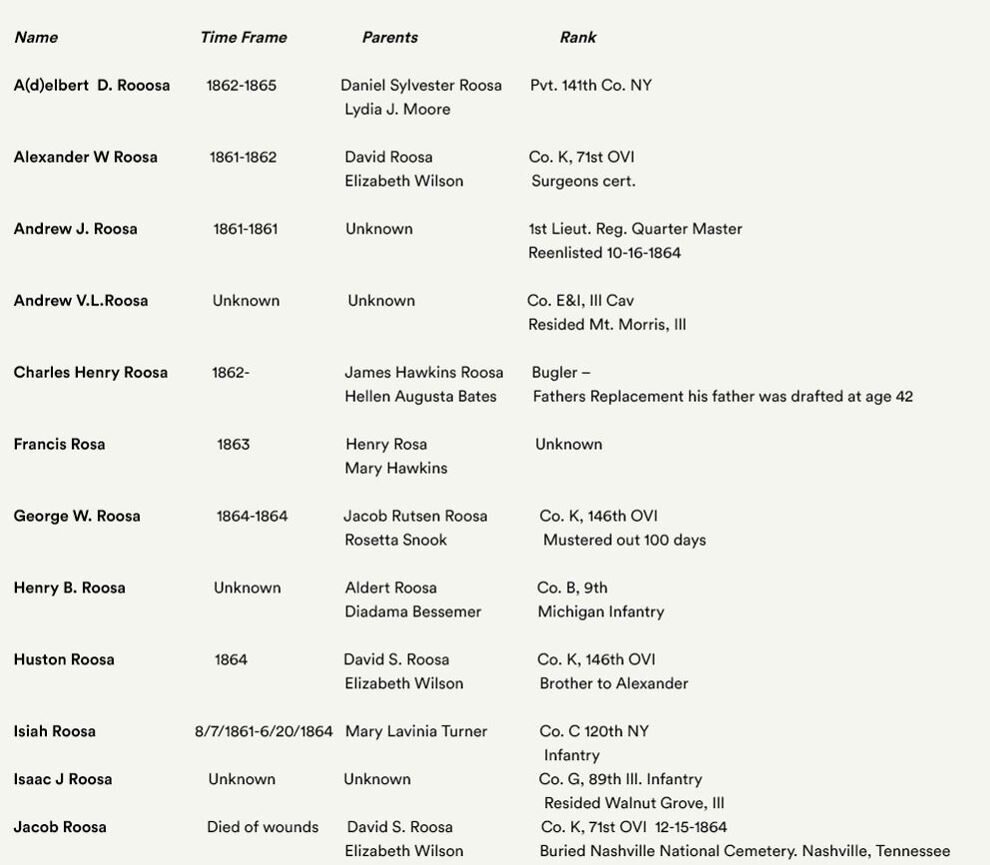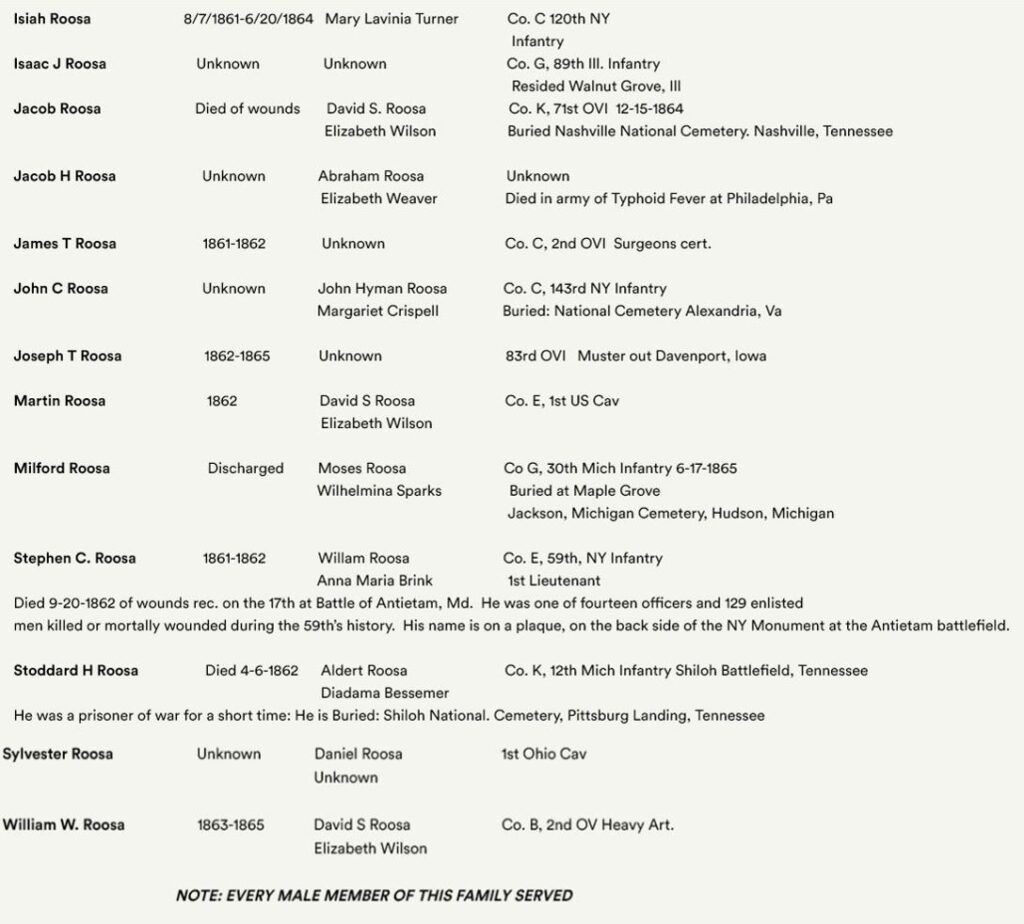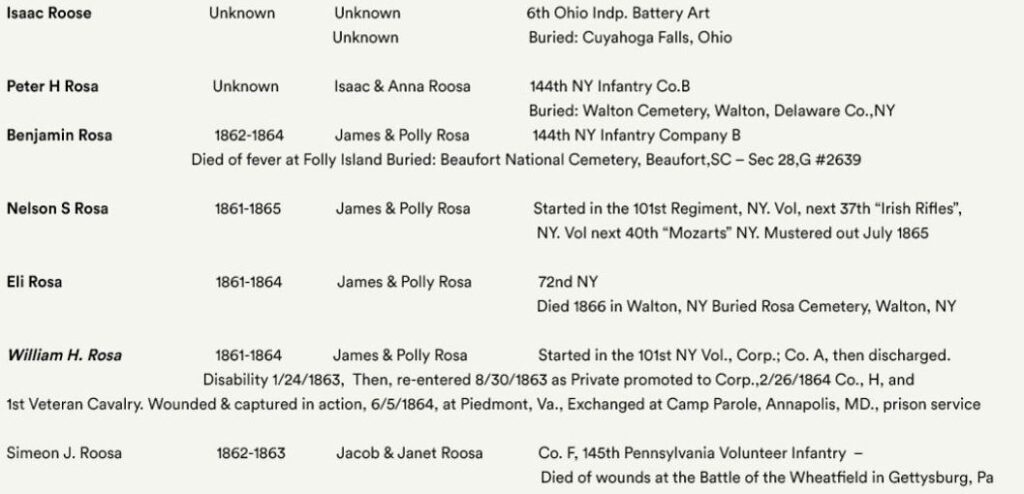Head of the Roosa Family
Aldert Heyman Roosa 1621-1679
Wyntie Ariens De Jongh 1623-1686
The head of the Roosa family in this country was Aldert Heyman Roosa born in Holland, in 1621 and his wife Wyntie Ariens De Jongh born in Holland 1623. They came to this country April 1660 on the ship called “The Spotted Cow”, with eight children, ages 17, 15, 14, 9, 8, 7, 4, and 2, respectively, and settled in Wiltwick, now Kingston, Ulster County.
History says Roosa was a wealthy man and brought many goods from Holland, became one of three first Magistrates, and laid out the town of Hurley, and was the leader and director of events. December 25th, 1660, he and his wife participated in the Lord’s Supper in the Dutch Church at Wiltwick, and in the spring of 1661, guaranteed to pay Dominie Hyman Bloom a salary as pastor. As the destruction of the town of Hurley by the Indians, June 7th, 1663, two of the Roosa children with 43 others including women and children were stolen by the Indians. This capture can be found in the History of the War in Ulster County. He died in 1679.
Jan Aldert Roosa, born in Holland, 1651, married Willegard W. VanBuren, born in Holland, 1653. He was a son of Aldert Heyman Roosa and Wyntge Ariens.
Aldert Jansen Roosa, born in Ulster County, 1676, married Rebecca Schepmoes, born 1687, son of Jan Aldert Roosa and Willegard W. Schepmoes.
Abraham Roosa, born March 18, 1718, married Elizabeth Rutson, born 1719, daughter of Col. Jacob Rutson, son of Aldert Jansen Roosa and Rebecca Schepmoes.
Isaac A. Roosa, born April 21st, 1751, married Catherine De La Montanye, born 1752, died 1809. Son of Abraham Roosa and Elizabeth Rutson, died 1803.
David Roosa, born October 25th, 1783, married Henrietta Osterhought, born 1784. Son of Isaac A. Roosa and Catherine De La Montanye, he died March 26th, 1846.
Abraham Roosa, born August 1st, 1810, died August 24th, 1879. Married Abigail C. Minard, born March 4th, 1814, died January 1st, 1835. Son of David Roosa and Henrietta Osterhought.
William M. Roosa, born in Ulster County, New York, youngest son of Abraham Roosa and Abigail Minard, married Mary Elizabeth Paulding, December 19th, 1878.
The other children of David Roosa and Henrietta Osterhought were Isaac Roosa, Luke Roosa, Henry Roosa (who was a twin of Abraham Roosa), John Roosa, Peter Roosa, and two daughters, Catherine Roosa and Harriett Roosa.
THE BEGINNING
The De Bonte Koe set sail 16 April 1660 from Amsterdam, arriving New Amsterdam
The Passenger List
Jan Soubanick, from Byle in Drenthe [NWI]
Albert Jansz from Drenthe [NWI]
Pieter Jacobsz, from East Friesland [NWI]
Cornelis Bartels, from Drenthe [NWI]
Steeven Koorts from Drenthe, wife and 7 children; 22, 10, 8, 6, 4, 2 yrs old [NWI]
Jan Kiers, farmer, and wife from Drenthe [NWI]
Focke Jansz, farmer from Drenthe, wife and 7 children: 19, 17, 13, 11, 9, 3 yrs old, and nursing child [NWI]
Claes Arentsz from Drenthe, wife and 3 children: 6, 4, 3/4 yrs old and a boy aged 14 [NWI]
Gerrit Egbertsz, farmer’s servant from Meppelt [NWI]
Beertien Dircx, maiden from Drenthe [NWI]
Egbertie Dircx, maiden from Drenthe [NWI]
Pieter Jansz, shoemaker from Drenthe, wife and 4 children: 15, 13, 9, 1/2 yr old [NWI]
Coert Cartensz, famer’s servant from Drenthe [NWI]
Roeloff Swartwout, farmer (on his return to New Netherland where he previously resided) [NWI]
Cornelis Jacobsz Van Leeuwen in the employ of Swartwout [NWI]
Arent Mertensz from Gelderland in the employ of Swartwout [NWI]
Ariaen Huijbertsz from Gelderland in the employ of Swartwout [NWI]
Albert Heymans Roosa, farmer, from Gelderland, wife Wyntje Ariens de-Jongh
and 8 children ages at time of sailing: 17, 15, 14, 9, 8, 7, 4, 2 yrs old [NWI]
Arie Heymanse Roosa b. ca 1643, m. Maritie Pels
Heyman Aldertse Roosa b. ca 1645, m. Anna Margriet Roosevelt
Jan Roosa, b. ca 1646, m. Hellegond Willemsen Van Buren
Eyke, Roosa b. ca 1651, m. Roeloff Kiersted
Maritje Roosa b. ca 1652, m. Albert or Laurens Jansen
Neeltjeb Roosa .ca 1653,m.Henry Pawling (Pauldin/Paeldin)
Jannetje Roosa b. ca 1656, m. Matys Ten Eyck
Aert Roosa b. ca 1658
Guert Roosa, d. 15 June 1664 just before baptism
Peter Timkam, tailor from Nimwegan, in the service of Director Stuyvesant [NWI]
Jan Jansz Mol [NWI]
Annetie Harmens, maiden, resides with paulus Leendertsz Van de Grift [NWI]
Beletie Foppe, resides with Jacob Leendertsz Van de Grift [NWI]
Elias Gijseling from Zeeland [NWI]
List of Soldiers [NWI]
Claes Petersen, Adelborst from Detmarsum
Claes Hayen from Bremen
Jan Petersen from Detmarsen
Gerrit Manneel van Haen
Conraet Croos from Switzerland
Hendrick Eyck from Srahuys
Christian Bartels Ruysh from Amsterdam
Hendrich Steveterinck from Osnasnigge
Peter Martens from Laens
John Hamelton of Hamelton [ENN: owes David Craffort for his transprotation]
Johan Verpronck from Bonn above Ceulen; a Smith and Baker [ENN: Johan Spronck from Bonn above Ceulen]
Jan Wilekheresen from Bergen in Norway
Peter Petersen from Amsterdam, 1with his Wife and 3 children
Brant Kemenes from Dockum [ENN: Brant Hemmes from Dockum]
Dirck Jansen from Rylevelt
Harman Jansen Engsinck from Oldenseel [ENN: Assigns wages per yer to Beertie Jansen, his mother]
Johannes Levelin from Bulhausen
Michiel Brouwnal from (Berg) Mont-eassel
Jurriaen Fransen [name crossed out]
Jans Hansen Graer [name crossed out]
THE BEGINNING Part 2
The De Bonte Koe set sailed 16 April 1660 from Amsterdam, arriving New Amsterdam
Aldert (Albert, Alaerdt, Allard) Heymansen ROOSA, the founder of the Roosa family in America, was born in 1621 in Herwynen, Gelderland, Netherlands. With his wife and eight children, the Roosa’s arrived at New Netherland on 15 Apr 1660 on the ship “De Bonte Koe, “the Spotted Cow.” Aldert was a wealthy man for his day and brought considerable property with him and quickly “occupied an influential position in the new settlement.”
In the spring of 1661, he joined in a contract guaranteeing a salary to Domine Blom who had been called as the regular pastor of the Dutch Church at Wiltwyck.
Upon their arrival, Aldert secured passage for himself and his family to Esopus (Kingston) and took up residence in the Esopus District at Wiltwyck by 1664. When a new village was laid out, he moved there, and from that time to his death he resided at Hurley. At the destruction of the village of Hurley on 7 Jun 1663 by the Indians, two of the Roosa girls with 43 others were taken captive. They were rescued by the colonial forces under the command of Captain Martin Kregier
After the surrender of the Dutch government to the English in 1664, Aldert led the revolt of the Burghers against military leaders. He and Cornelius Barentsen Slecht and two others were found guilty of a rebellious and mutinous riot at Esopus and were taken to New York for sentence. Roosa was to be banished for life out of the government and the others for shorter terms out of Esopus, Albany, and New York. Each of their sentences was later modified and the offenders returned to Esopus.
Governor Francis Lovelace restored Roosa to favor and in 1669 appointed him and Luis Du Bois two of overseers for Hurley (New Dorp) or New Village. Roosa also served in the military forces of the Colony as a mustering officer and in other capacities. He died 27 Feb1679 at Hurley, Ulster Co., NY.
He was married circa 1642 to Wyntje Ariens de Jonge, the daughter of Adrian Miertensen de Jonge and Maritje. Wyntje was born about 1630 probably in Holland.
On March 3, 1660 (1036) Albert, living in Herwijnen, conveyed half a tract of land as yet undivided between the heirs of Govert Ariensen De Jongh, in Hellouw ( a mile or so from Herwijnen) and again he pledged his interest in the estate of the late (2074) Adrian MeertensenDe Jongh as security for the fulfillment of the contract. It is further proof that the wife of (1036)Albert was the daughter of (2074) Adrian Meertensen De Jongh. The (2074) De Jongh family owned large fowler preserves in Hellouw in the 17th century. (1036) Albert and his family arrived in New Netherlands on April 15, 1660, aboard the good ship “De Bonte Koe” or “Spotted Cow”.He was a wealthy man for those days, bringing with him considerable property from Holland, and he speedily occupied an influential position in the new settlement. In the spring of 1661, he joined a contract guaranteeing a salary to Domine Bloem who had been called as the regular pastor of the Dutch Church at Wiltwyck.
For subsequent events, see The Esopus War, the Wiltwyck Massacre, and the Mutiny Against the English
(1036) Albert Heymans was banned from holding public office after the Esopus Mutiny. His sentence was subsequently modified, and he returned to Esopus. Governor Francis Lovelacerestored (1036) Roosa to favor and in 1669 appointed him as one of the Overseers for Hurley, called New Dorp or New Village. In 1673 he was confirmed as one of the officers at Esopus by Governor Anthony Colve and described as (1036) “Captain Albert Heymans, who had been prominent in the riot of 1667”. (1036) Albert served in the military forces of the Colony as a mustering officer and in other capacities and on April 5, 1670, at the military rendezvous held atMarbletown, he was present as Sergeant of Captain Henry Pawling’s Company which also appeared his son (518) Arie Roosa as private, and in 1673 (1036) Albert was Captain of a company recruited from Hurley and Marbletown. —
Spouses
Children
Arie Heymanse Roosa b. ca 1643, m. Maritie Pels
Heyman Aldertse Roosa b. ca 1645, m. Anna Margriet Roosevelt
Jan Roosa, b. ca 1646, m. Hellegond Willemsen Van Buren
Eyke, Roosa b. ca 1651, m. Roeloff Kiersted
Maritje Roosa b. ca 1652, m. Albert or Laurens Jansen
Neeltjeb Roosa .ca 1653,m.Henry Pawling (Pauldin/Paeldin)
Jannetje Roosa b. ca 1656, m. Matys Ten Eyck
Aert Roosa b. ca 1658
Guert Roosa, d. 15 June 1664 just before baptism
The Beginning Part 3
ALEARDT, Aldert or Albert Heymanse Roose came to this country from Harwyen, also spelled Herweyen, in Gelderland, Holland, on Waal river, five miles west of Bommel. Or it may be the present Heywennen, a short distance east of Bommel in Gelderland or the present Herwen in Gelderland twelve miles sontheast of Arnhem. With him came his wife, Wyntje (Lavinia) Allard or Ariens, and eight children in the ship Bontekoe (Spotted Cow), Captain Peter Lucas April 15, 1660; and settled in the Wildwyck district of Esopus, now Kingston, Ulster County, New York. Of these eight children: Heyman, born in 1643, married Maritje Roosevelt. Arie, born in 1645, married Maria Pels. Jan, bom in 1651, married Hellegond Williamse Van Buren. lkee or Aaghe married Dr. Roelof Kiersted. Maritje married Laurens Jansen. Neeltje married Hendrick Pawling after Nov. 3, 1676. Jannetje married Mattys TenEyck at Hurley Nov. 16, 1679. Aert. Two other children were born to him and his wife after coming to New Netherland, viz; Annatje and Guert.
From the fact that in Gelderland at the present time the language of its people is interspersed with Spanish words and idioms it has been supposed that many religious refugees from Spain during the first years of the Inquisition settled in this particular Province of Holland, among whom may have been ancestors of Albert Heymanse; if so, this can account for the spelling of the name, by the Hollanders-Roose -which to them would produce the same sound as Rosa, his name in Spanish.
On December 25, 1660, Aldert Heymanse Roosa and his wife, with Anna Blom, Jacob Joosten, Jacob Burhans, Mathias Blanchan and wife, Anton Crespel and wife, Andries Barentse and wife, Margaret Chambers, Gertruy Andries, Roelof Swartwout and wife, and Cornelise Sleght and wife participated in the first administration of the Lord’s Supper at the Esopus or Wildwyck. Aldert Heymanse Roosa was a wealthy man for those days, bringing with him considerable property from Holland, and he speedily occupied an influential position in the early making of Kingston, in all of which he appeared as a leader and director of events. On the fourth of March, 1661, he joined with Thomas Chambers, Cornelis Barentse Sleght. Gertruy Andries, Roe of Swartwout and Jurian Westvael in a contract guaranteeing a salary to the Reverend Hermanus Blom, who had been called as pastor of the Dutch church at Wildwyck. Of this church he was for many years an elder; and because of the energy with which Domine Blom and he sought to conserve the surplus of the estates of deceased parents for the benefit of the poor of the village he was sometirnes called ” the consistory ” of the church.
On the 5th day of May, 1661, Evert Pels, Cornelis Barentse Sleght and Aldert Heymanse Roosa were appointed commissaries at Wildwyck and took their oath of office, and on the 16th day of the same month Peter Stuyvesant, in behalf of the Mighty Lords, the States General of the United Netherlands, and the Lord Directors of the Privileged West India Company granted its first charter to Wildwyck, in which Evert Pels, Cornelis Barentse Sleght and Aldert Heymanse Roosa were appointed schepens, and therein designated as ‘- interested, intelligent persons, possessing Real Estate, peaceable men, professors of the Reformed religion as it is now preached in the, United Netherlandish Churches in conformity through the Word of God, and the orders of the Synod of Dordrecht.” And new lots were then laid out at Wildwyck, Of which Aldert Hymanse Roosa was allotted No. 24 and his son Jan No. 30.
On April 6th, 1662 permission was given by the Director-General to lay out a new village at the Esopus. It was called Nieuw Dorp, now Hurley, at which place Matthew Blanshan and his sons-in-law, Anthony Crespel and Louis DuBois settled the same year. Directly after this warnings were received and sent to New Amsterdam of pending troubles from the Indians at the Esopus. (Col. Hist. N. Y., Vol. XIII., pages 227-228). On the 11th of October, 1662, Aldert Heymanse Roosa was commissioned to proceed to New Amsterdam to obtain one hundred pounds of powder and two hundred pounds of lead for the protection of the old and new settlements. (Col. Hist. N. Y., Vol. XIII., page 231.)
Aldert Heymanse Roosa must have been among the earliest settlers of the new village because on March 30, 1663, he, Jan Joosten and Jan Garretsen were appointed by Director-General Stuyvesant commissaries to lay out and fortify it with palisades for protection against attacks of savages. (Sylvester’s Hist. Ulster county, page 36).
On the 7th of April, 1663, Aldert Heymanse Roosa and his fellow commissaries reported to Governor Stuyvesant that the savages would not allow the building of palisades or fortifications at the new village, because the land was not included in the treaty made with them in the year 1660, and had not been fully paid for; and praying that the gifts promised the savages the previous autumn be sent at once, and that the new place and village be assisted with a few soldiers and ammunitions of war, at least, until the new settlement should be put into a proper state of defense and inhabited by a good number of people; that ‘your humble and faithful subjects may remain without fear and molestation from these barbarous people, and with some assurance for the peaceful, undisturbed and unhindered continuation of the work begun, for if rumors and warnings may be believed, it would be too anxious, if not too dangerous an undertaking for your humble petitioners and faithful subjects to continue and advance their work otherwise.” (Col. Hist. N. Y., Vol. XIII., pages 242-3).
These warnings were not heeded and these earnest requests were not complied with, and on June 7th, 1663, the Indians attacked the New Village and Wildwyck. At Wildwyck they burned twelve dwelling houses; murdered eighteen persons, men, women and children, and carried away ten persons more as prisoners. The New Village was burned to the ground and its inhabitants mostly taken prisoners or killed. Only a few of them escaped to Wildwyck, among wnom were Roosa, Blanchan, Crespel and DuBois. So there were sixty-five persons missing in general, either killed or captured, besides nine pesons who came to Wildwyck, severely wounded. Among those taken prisoners at the New Village were the wife and two children of Louis DuBois; wife and one child of Anton Crespel; two children of Matthew Blanshan; two children of Aldert Heymanse Roosa and wife and three children of Lambert Huybertse Brink. (Col. Hist. N. Y. Vol. Xlll., pages 245-6, 256- 372).
An account of the massacre was sent to New Amsterdam on the 10th of June, and written instructions were received from the Director-General, under date of June 14th for the guidance of the officers at Wildwyck. Martial law was proclaimed and a council of war formed to consist of Ensign Niessen, Captain Chambers, Lieutenant Hendrick Jochem Schoonma ker of the Burgher Guard and the schout and commissaries of the village to deliberate and decide what might be necessary for the welfare of the village after the massacre. Mattys Capito was appointed secretary of the council. Aldert Hermanse Roosa was one of the commissaries. He was also corporal of the Burgher Guard of which Hendrick Jochem Schoonmaker was lieutenant.
Captain Martin Cregier reached Esopus on the 4th day of July, 1663, and proceeded to Wildwyck, where he found that the magistrates had examined some Esopus Indians and the wife of Dr Gysbert van Imbroeck, who had been a prisoner, and had practically located the place where the prisoners were held. On the 7th day of July, Aldert Heymanse Roosa and some other farmers, being indignant at the neglect of those in authority at New Amsterdam in sending them relief when requested in the early part of April, and sorely vexed at the delay of Captain Cregier in conducting the organization of the expedition against the Indians for the rescue of the prisoners, appeared armed before the council, who were examining two Wappinger Indians and upon being asked what they were doing there with their guns, gave answer: “We intend to shoot these Indians ” Upon being told that they must not do that, they replied to Captain Cregier that they would do it, even if he stood by.
On July 26th an expedition about two hundred strong, of which one hundred and forty-five were inhabitants of Wildwyck, set out for the Indian “old fort” at Kerhonkson where the captives were reported to be. Reaching it on the 26th they found it deserted. Cregier destroyed about two hundred and fifteen acres of maize and burned about one hundred pits of corn and beans. A second expedition guided by a young Wappinger Indian started on September 3rd for the Indian entrenchment known as “new fort,” which was situated in Shawangunk. Besides the troops, on this expedition, seven of the citizens of Wildwyck accompanied it. Although the names of the citizens are not given in Captain Cregier’s report the seven, probably, were Matthew Blanshan, Louis DuBois, Anton Crespel, Cornelis Barentse Sleght, Tjerck Claesen DeWitt, Aldert Heymanse Roosa and Lambert Huybertse Brink, members of whose families were among the captives of June 7th, and each of whom must have accompanied either the first or second and, possibly, both expeditions.
Here at the “new fort” the Indians were attacked and a chief, fourteen warriors, four women and three children were killed, probably many others were wounded, who escaped. Of Cregier’s forces three were killed and six wounded Twenty-three Christian prisoners were rescued. ” New Fort” was situated in the town of Shawangunk on the east bank of the Shawangunk kill, two miles south of Bruynswick and twenty-eight miles from Kingston (Schoonmaker’s Hist. of Kingston, page 39. OLDE ULSTER, Vol II, pages 1-9).
After the Dutch had surrendered New Netherland to the English in 1664 and Richard Nicolls had become governor, Captain Daniel Brodhead, with a company of English soldiers was sent to Wildwyck. Against the arbitrary conduct of Captain Brodhead and the indignities put upon the Dutch settlers by the English soldiers, Aldert Heymanse Roosa led the revolt of the burghers in 1667 against the military authorities, which is referred to historical books as the ” Mutiny at Esopus.”
Marius Schoonmaker, in his history of Kingston, commenting on this revolt writes: Mutiny is resistance to the exercise of lawful power. If an officer invades the house of a subordinate to steal, commit an assault or a trespass, resistance is not mutiny; and much more, the moment a military officer or soldier steps outside of his military calling and wilfully commits an assault or a trespass against a citizen, or unlawfully deprives him of his liberty, the military character or privilege is at once doffed and thrown aside, and resistance is not mutiny. It was justifiable resistance to tyranny and oppression-an outburst of the same spirit which subsequently threw off the oppressor’s yoke in 1776, and carried this country triumphantly through the Revolution.
For instigating this revolt Aldert Heymanse Roosa and other burghers were tried before Cornelis van Ruyven, one of the king’s justices of the peace, and on May 3, 1667, he was sentenced to be banished from the colony for life, and a fine of one hundred bushels of wheat, or the value thereof, was levied on his estate in Esopus for charges of the Court; and his son Arie, Antonio Delba and Cornelis Barentse Sleght were banished out of Esopus, Albany and New York for shorter terms.
The report and findings of this trial show that the matter was prejudged under secret instructions to carry out private orders, and not governed by the merits or the evidence in the case. The trial however resulted in the suspension of Captain Brodhead from his command and in less than three months, on July 14th he died at Esopus leaving his widow and three sons -Daniel, Charles and Richard — surviving him (History of Kingston, page 57).
The sentences of the burghers participating in this revolt were subsequently modified and Aldert Heymanse Roosa was permitted to retum to Wildwyck, and with Louis DuBois was appointed by Governor Francis Lovelace September 16th, 1669, overseer for Hurley (Col. Hist. N. Y. Vol. XIII., page 436).
On the 30th day of March, 1670, he set over to Governor Lovelace eight acres of land as part of ” the Transport” to satisfy the inhabitants of the town of Marbletown for the grant given to them under the authority of the governor (Col. Hist. N. Y. Vol. XIII., page 445). At this time he received a patent tor ten acres and four hundred and fifty rods at Hurley, and was commissioned sergeant of the militia directed to be present at the rendezvous at Marbletown April 5th, 1670.
On April 7th, 1670 he was appointed overseer of Hurley and Marbletown and on October 25th, 1671, in an order of Governor Lovelace ” Regulating the Civil and Military affairs of Kingston,” Aldert Heymanse Roosa was appointed commissary for Hurley, and the eldest commissary for Kingston (Col. Hist. N. Y. Vol. XIII., pages 448, 450, 460).
When Charles II. of England joined Louis XIV. of France in a compact to destroy Dutch freedom, war broke out again. In Holland the Dutch cut the dykes, put their country under water and drove out the French invaders. The news of a Dutch fleet approaching New York was received with joy and on the 7th of August, 1673, twenty three Dutch war-ships with 1,600 soldiers entered New York Bay and on the 9th of August the flag of Holland floated again over Manhattan, and Captain Anthony Colve was made governor. In this state of war delegates from Esopus, under date of September 1st,1673, presented a petition to the Dutch governor, praying that certain persons be appointed to govern the village of Esopus, formerly Wildwyck, then called Swanenburgh, Hurley and Marbletown, with a military organization and the necessary ammunition. The petition was granted on condition that no one should be nominated who was not of the Reformed religion, nor ” who was not well inclined towards the Dutch nation.” Aldert Heymans Roosa was on October 6th, 1673, appointed captain of Hurley and Marbletown by Governor Colve, and described as ” Captain Aldert Heymans, who had been prominent in the riot of 1667.” (Col. Hist. N. Y. Vol. XIII., page 475. Vol. II., page 626 Report State Historian New York, Colonial Series (1896) page 384).
Aldert Heymanse Roosa died at Hurley, New York, February 27th 1679. (See New York Gen. and Biog. Record, Vol. VXXI., pages 163-166, 235-237. Anjous Ulster County Wills, Vol. I., page 74).
Reaching across 400 years to Hurley’s Early Dutch Settlers
by Patricia and Jeffery Burke | 4/29/2020
Introduction and Discovery
Patricia recently volunteered to be Chairperson of the Heraldry Committee at her local Chapter of Colonial Dames 17th Century. She soon learned Heraldry is a significant aspect of the society’s mission and having an approved Coat of Arms is an important part of their record-keeping.
While looking at a list of Colonists with approved Coats of Arms, we surprisingly discovered two of her ancestors were included: Aldert Hymans Roosa and his wife Wyntje Ariens de Jongh. To emphasize, in addition to the Roosa shield there is a separate one for Wyntje! Apparently, a Coat of Arms allowed a person the right to bear arms.
Historical Background
Aldert Hymans Roosa is the ancestor of the Roosa family in America. He and his wife Wyntje were born in Herwynen, Gilderland, Netherlands circa 1621 and 1623, respectively. They married about 1642 and with daring and their eight children, came to New Netherlands in 1660 on the ship De Bonte Koe (Spotted Cow), initially settling in Wiltwick/Esopus (now Kingston, NY) where he became a prominent and sometimes controversial citizen.
Roosa was an agriculturist and a wealthy man for those days, bringing with him considerable property from Holland, and he speedily occupied an influential position in the new settlement. For example, Aldert’s name appears with that of his son Arien Albertson Roosa, Louys Du Bois, and others to petition Sir Edmund Andros, Governor of New York, praying that he would assist them in procuring a minister for Esopus, “that can preache boitthe Inglish and Dutche which will be most fitting for this place, it being in its minority.” This effort was successful for on December 25, 1660, Aldert and Wyntje participated in the first administration of the Lord’s Supper given by the Rev. Harmanus Bloem, who had been called as the regular pastor of the Dutch Church at Wiltwyck. In the spring of 1661, Aldert joined in a contract guaranteeing a salary to Rev. Bloem.
In 1662, Roosa was appointed one of three commissioners to enclose the new village at the Esopus, called Nieuw Dorp (now Hurley). At the destruction of this village on June 7, 1663 “by the Indians,” two Roosa children were taken captive along with 43 other women and children.
Rebellion and Reprieve
It seems Aldert was not receptive of the emerging British influence and in 1667 he joined with Cornelis Barentsen Slecht and two others in a rebellious and mutinous riot. They were found guilty and taken to New York for sentence. Nichols, by advice of his council, on the 3rd of May, sentenced Heymans to be banished for life out of the government, and the others for shorter terms, out of Esopus, Albany, and New York. All these sentences of the burghers were subsequently modified, and the offenders returned to Esopus. Governor Francis Lovelace restored Roosa to favor and in 1669 appointed him and Louis Du Bois, two of the overseers for Hurley, formerly called Nieuw Dorp or New Village. “In 1673 he was confirmed as one of the officers at Esopus by Governor Anthony Colve, and described as Captain Albert Heymans, who had been prominent in the riot of 1667.”
Aldert and his family subsequently relocated to Hurley where he and Wyntje resided for the remainder of their lives. He died in 1678/79 and she died sometime after 1685 when she was recorded as securing a grant of 320 acres at Hurley.
Lineage
What is notable about Patricia’s lineage is that she is descended from Aldert and Wyntje on her father’s and mother’s side. Aldert and Wyntje had a son, Arie Hymansz Roosa who married Maria Evert Pels. They had several children including Wyntje Roosa (named after Arie’s mother), wife of Nicholas DePuy and they are direct ancestors of Patricia’s father, Alfred William O’Dea.
Arie and Maria had another daughter, Ariaantje Roosa, wife of Teunis Oosterhout and they are direct ancestors of Patricia’s mother, Grace Marion Chapman.
This lineage spanning 12 generations can be seen in Image #1. Note there are four American Revolutionary War soldiers represented here.
Heraldry
The governing authority for approving a Coat of Arms in America is the Committee on Heraldry of the New England Historic Genealogical Society located in Boston, MA. After reaching out to the Chairman, he responded by sending minutes of two meetings, in 1939 and 1940, that resulted in the approvals for Aldert and Wyntje. Interestingly, the application for these approvals was Marguerite du Pont Ortiz Boden (Mrs. Harry Clark Boden) of Newark, Delaware. She was a member of the du Pont family and was involved with many genealogical societies.
Reference Image #2 for Aldert and Wyntje’s approved Coats of Arms.
Summary
The confluence of separate lineages spanning 400 years and twelve generations is a genealogy treasure highlighted by the discovery of separate Coats of Arms awarded to Patricia’s 9th great-grandparents of the 17th Century and early Dutch colonists of Hurley.
Sources:
Historical Background, Rebellion and Reprieve
- 1888 The History of Kingston, New York, by M. Schoonmaker, p. 485
- 1891 Baptismal and Marriage Registers of the Old Dutch Church of Kingston, Ulster County, NY 1660-1809, by RR Hoes, #175, p. 11
- 1905 Pawling Genealogy, by AS Pawling, p. 13, 24-27
- 1910 New York Genealogical and Biographical Record, Vol. XXXI, “The Roosa Family of Ulster and Dutchess Counties, New York,” by Holdridge Ozro Collins, of Los Angeles, California, p. 163-166
- 1982 Genealogies of Pennsylvania Families from the Pennsylvania Genealogy Magazine, indexed by T. Holloway and E. Antoniak, p. 12
- 2019 homepages.rpi.edu (Albert Heymans Roosa)
Genealogy: - Patricia’s lineage to four American Revolutionary War Ancestors: National Society Daughters of the American Revolution; National No. 923650
- Patricia’s lineage from American Revolutionary War Ancestors to Aldert Hymans Roosa and Wintje Ariens de Jongh: Society of Colonial Dames XVII Century, submission to Colorado Registrar, 2020; National No. 42288
- Patricia’s Dutch lineage: Society of Holland Dames, Member No. 846
Roosa Military Service Record
Roosa Descendants
excerpt from the book by Arthur G. Roosa
In the war of 1776, The American Revolution, Abraham Roosa was a private soldier in the Second New York Regiment, Continental Line, Also in Col. Albert Pawling’s Regiment of new York Levies, and in the 2nd Regiment of Ulster County, New York, also a Sergeant in Col. Hathrom’s Regiment of New York Militia.
His son, Isaac A. Roosa was commissioned as Ensign in the 4th New York line, Nov. 21st. 1776, and a Lieutenant in the same Regiment, Nov. 9th, 1777. Resigned Jan. 22nd, 1778. Was Lieutenant in the exempts of Hanover, Ulster County, New York, Sept. 30,1778.
In the War of 1812, David Roosa, son of Isaac A. Roosa, was in Captain John Bogart’s Company of Col. Bevier’s Regiment, New York Militia from Sept. 5th , to December 18th, 1814.
Aldert Heyman Roosa, Born in Holland in 1621, came to this country from Gelderland, Holland, on Wall (Waal) River, five miles west of Brommel (Bommel), April 15th, 1660 with his wife Wyntge Areins and eight children, born in Holland in 1622, on the ship “Spotted Cow” in command of Captain Peter Lucas and settled in Wilt Wyck of Esopus, now Kingston, Ulster County, N.Y. He was a wealthy man and brought much property from Holland. He speedily achieved an influential position in the early making of Kingston. In all he appears as leader and director of events. On May 5th, 1661, he was appointed Commissioner of Wilt Wyck and took the oath of office 16th of May. Peter Stuyvesant in behalf of the Mighty Lords, the stated General and the Lord Directors of the United Netherlands, granted Wilt Wyck it’s first charter and Aldert Heyman Roosa was appointed Magistrate and therein designated an intelligent person. On the 11th of October, 1662, Roosa was commissioned to proceed to New Amsterdam to obtain 100 pounds of powder and 200 pounds of lead for the protection of the settlement. On April 7th, 1663, Roosa reported to Governor Stuyvesant that the savages were getting troublesome and suggested that the gifts promised them in the Treaty of 1660 be sent to them at once and a few soldiers and munitions of war to protect the settlement also be sent. The warning was not heeded and his earnest requests were not complied with and on the 7th day of June, 1663, the Indians attacked the New Village and Wilt Wyck. At Wilt Wyck they killed eighteen persons and took ten prisoners, burning twelve houses. New Village was burned to the ground. Out of seventy-eight inhabitants sixty-five were killed or taken prisoner. Roosa with twelve others escaped to Wilt Wyck. Of these nine were severely wounded. On July 26th an expedition two hundred strong started out to look for the Indians. Of this number 145 were inhabitants, leaving 36 soldiers in the garrison, but they failed to find the Indians. After burning 200 acres of corn and 100 pits of beans, they returned to Wilt Wyck.
On September 3rd a second expedition started out, besides the troops, the expedition included seven citizens of Wilt Wyck, of whom Roosa was one. The Indians were found on the Shawangumh Kill, twenty-eight miles from Wilt Wyck. The Indians were attacked. Their Chief and fourteen warriors, four white woman and three children were killed and twenty-three prisoners were rescued, among whom were Roosa’s two little girls, Elizabeth and Anita. The white women and children were killed in a crossfire in the battle.
After the Dutch had surrendered to the English in 1664, the English soldiers were sent to Wilt Wyck to replace the Dutch officials. In protest against the indignities put on the Dutch settlement by the English soldiers, Aldert Heyman Roosa, in 1667, led the revolt against the military authorities. For this Roosa was tried before one of the King Justices and was sentenced to be banished from the Colony for life and fined 100 bushels of wheat. It was afterwards proved that the trial was prejudiced and the English Captain was suspended (Captain Broadhead) and Roosa was returned. An outburst of the same spirit which threw off the oppression yoke in 1776 and carried this country triumphal through the Revolution. April 7th, 1670, he was appointed Overseer of Hurley and Marbletown and October 25th, 1671, by an order of Governor Loveler, Roosa was appointed Commissioner for Kingston. On the 7th day of August, 1673, twenty-three Dutch warships with 1600 soldiers entered New York Bay, and on the 9th the Dutch flag floated over Manhattan and Colonel Anthony Colve was made Governor and on October 6th, 1673, Aldert Heyman Roosa was appointed captain over Hurley and Marbletown by Colve and described as captain Aldert who had been prominent in the Revolt of 1667. Captain Roosa died at Hurley, on February 27th, 1679.
THE AMERICAN REVOLUTION
Roosa Patriots
The highest tribute to the departed is not grief but gratitude
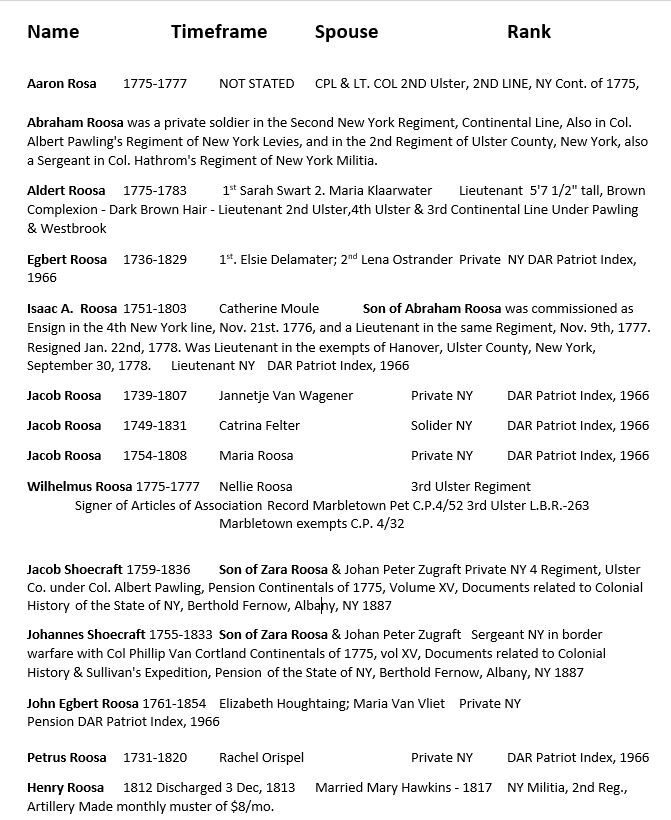
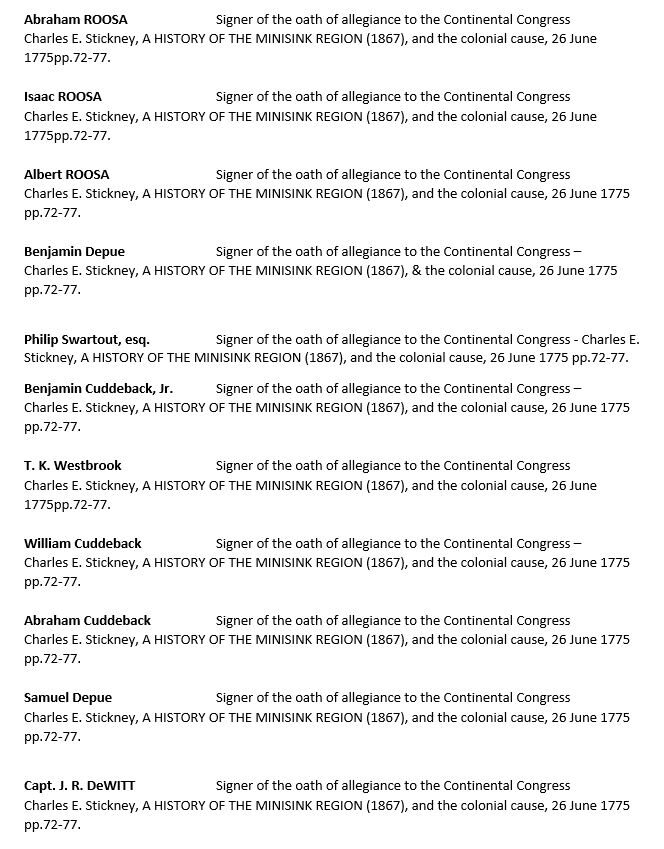
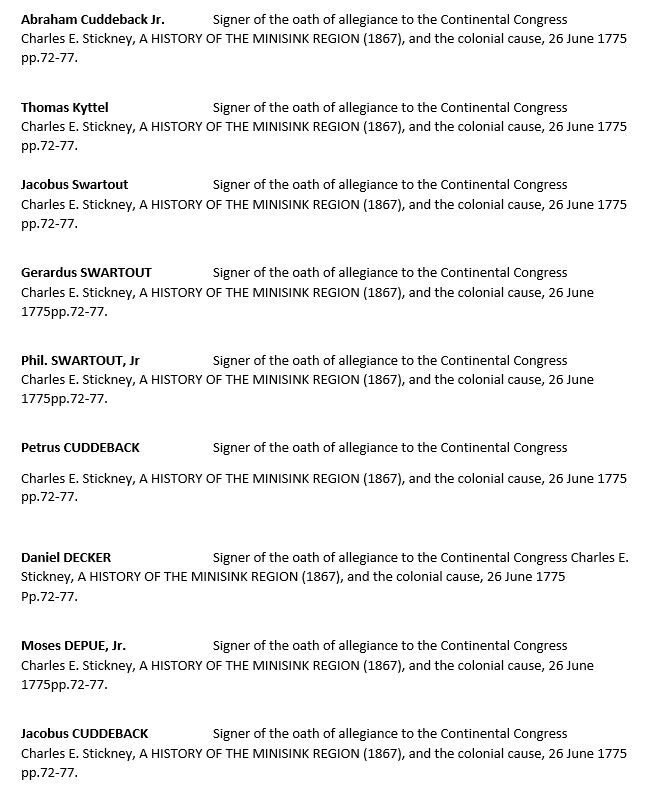
THE AMERICAN CIVIL WAR
Roosa Patriots
The highest tribute to the departed is not grief but gratitude
